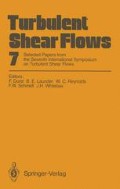Abstract
Measurements have been made in two axisymmetric single-stream mixing layers, each subjected simultaneously to curvature and divergence. The boundary layer was turbulent at separation. In the ‘very-strongly-strained’ layer, the curvature was entirely of the stabilizing sense. The large-scale structures were suppressed but not destroyed. Compared with what would be expected for curvature alone, the effect of divergence was to resist the suppression of the large-scale structures, and to increase the rate of recovery. In the ‘moderately-strained’ layer, destabilizing curvature followed the stabilizing curvature. The Reynolds stresses and triple-velocity products varied qualitatively as the lagged strains, though, quantitatively, destabilizing effects are unlikely to have been absent in the lagged region of stabilizing curvature. The approach of an undistorted layer to asymptotic stress levels is distinctly nonmonotonic.
Access this chapter
Tax calculation will be finalised at checkout
Purchases are for personal use only
Preview
Unable to display preview. Download preview PDF.
Abbreviations
- U r :
-
Reference velocity
- U max :
-
Maximum U at constant s
- R :
-
Radius of curvature, negative for concave (i.e. stabilizing) curvature
- s,n :
-
Shear layer curvilinear orthogonal axes, with n positive towards the low-velocity side
- x,y,z :
-
Cartesian axes
- X,r,Φ :
-
Cylindrical axes—X aligned with symmetry axis
- Γ:
-
Angle between X and tangent to s
- U,V,W :
-
Mean velocities in s-n-Φ directions
- u,v,w :
-
Velocity fluctuations in s-n-Φ directions
- q 2 :
-
= u 2 + v 2 + w 2
- Λ:
-
Gradient thickness, Λ = U max/(∂U/∂n)n = 0
- θ :
-
Momentum thickness
- Φ,k :
-
Spectral density, and wavenumber:
$$ {u^2} = \int {{\Phi_{{11}}}(k)dk,\,{v^2} = } \int {{\Phi_{{22}}}(k)dk} $$
References
Birch, S. (1980): Planar mixing layer data evaluation, Stanford Conference on Complex Turbulent Flows
Birch, S. (1983): The effects of initial conditions on high Reynolds number jets. AIAA paper 83-1681
Bradshaw, P. (1966): The effect of initial conditions on the development of a free shear layer J. Fluid Mech. 26, 225
Bradshaw, P. (1973) Effects of streamline curvature on turbulent flow AGARDograph 169
Bradshaw, P. (1975): Review—Complex Flows. J. Fluids Eng. 97, 146
Castro, I. P. (1988): Free-stream turbulence effects on separated shear layers, Zaric Memorial Seminar, Dubrovnic
Castro, I. P., Bradshaw, P. (1976): The turbulence structure of a highly curved mixing layer. J. Fluid Mech. 73, 265
Foss, J. F. (1977): The effects of laminar/turbulent boundary layer state on the development of a plane mixing layer, 1st Turb. Shear Flows Symp. Penn. State Univ.
Gibson, M. M., Rodi, W. (1981): A Reynolds-stress closure model of turbulence applied to the calculation of a highly curved mixing layer. J. Fluid Mech. 103, 161
Gibson, M. M., Younis, B. A. (1983): A Reynolds-stress closure model of turbulence applied to the calculation of a highly curved mixing layer. Expts Fluids 1, 23
Gillis, J. C., Johnston, J. P. (1983): Turbulent boundary-layer flow and structure on a convex wall and its development on a flat wall. J. Fluid Mech. 135, 123
Husain, Z. D., Hussain, A. K. M. F. (1979): Axisymmetric mixing layer: influence of initial and boundary conditions. A.I.A.A. 17, 48
Hussain, A. K. M. F., Clark, A. R. (1981) On the coherent structure of the axisymmetric mixing layer: a flow-visualization study. J. Fluid Mech. 104, 263
Keffer, J. F. (1965): The uniform distortion of a turbulent wake. J. Fluid Mech. 22, 135
Savill, A. M. (1987): Recent developments in rapid distortion theory. Ann. Rev. Fluid Mech. 19, 531
Smits, A. J., Eaton, J. A., Bradshaw, P. (1979): The response of a turbulent boundary layer to lateral divergence J. Fluid Mech. 94, 243
Smits, A. J., Joubert P. N. (1982): Turbulent boundary layers on bodies of revolution J. Ship Res. 26, 135
Townsend, A. A. (1980): The response of sheared turbulence to additional distortion. J. Fluid Mech. 98, 171
Wood, D. H., Bradshaw, P. (1982): A turbulent mixing layer constrained by a solid surface. Part 1. Measurements before reaching the surface. J. Fluid Mech. 122, 57
Wood, D. H., Bradshaw, P. (1984): A turbulent mixing layer constrained by a solid surface. Part 2. Measurements in the wall-bounded flow. J. Fluid Mech. 139, 347
Author information
Authors and Affiliations
Editor information
Editors and Affiliations
Rights and permissions
Copyright information
© 1991 Springer-Verlag Berlin Heidelberg
About this paper
Cite this paper
Johnson, A.E., Hancock, P.E. (1991). The Effect of Extra Strain Rates of Streamline Curvature and Divergence on Mixing Layers. In: Durst, F., Launder, B.E., Reynolds, W.C., Schmidt, F.W., Whitelaw, J.H. (eds) Turbulent Shear Flows 7. Springer, Berlin, Heidelberg. https://doi.org/10.1007/978-3-642-76087-7_19
Download citation
DOI: https://doi.org/10.1007/978-3-642-76087-7_19
Publisher Name: Springer, Berlin, Heidelberg
Print ISBN: 978-3-642-76089-1
Online ISBN: 978-3-642-76087-7
eBook Packages: Springer Book Archive

